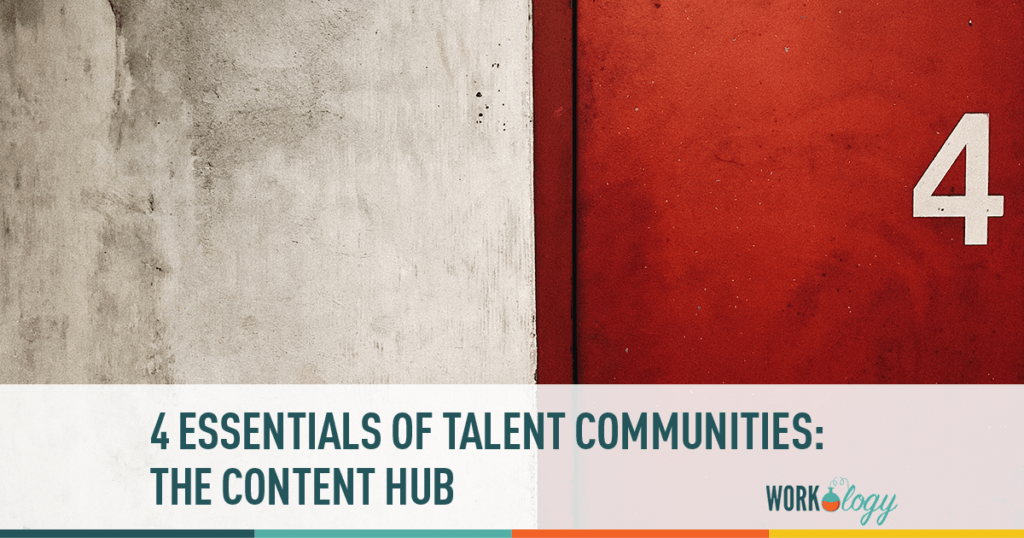This is Part 2 of a 4 part series on Talent Communities. In Part 1, we discussed that Talent Communities have four basic pillars for success: commitment, strategy, content, and membership… it’s as simple as that. Yet its simplicity is somewhat duplicitous as what comprises each pillar is complex. What’s the saying… the devil’s in the details? When it comes to creating successful online communities; success lies largely in the details.
Understanding Content & the Digital Content Strategy
CONTENT
“Thirty spokes share one hub. Make the nothing therein appropriate, and you will have the use of the cart.” ~Tao Te Ching
It is the center hub of the wheel that makes it work; because it is that which allows room for the axle that it rotates upon. Without the space of the center hub, regardless of the strength in numbers provided by the spokes; the cart is useless… the axle cannot connect and so the cart will not move. In terms of the online community and your overall digital strategy; the “center hub” is the content. Content on it’s own is nothing, really; but properly & consistently applied within the community & creates the axle that ‘make appropriate the space:’ conversations. Conversations serve as the ‘friction’ that keeps the wheel turning; making the cart useful for its members & allowing you the use (purpose) for which it was created.
When considering content types, it’s not nearly enough to get members to consume (read) what you put out; it needs to compel members to actively “talk” about what was shared. Ideally, content should be complex enough to drive open-ended discussion; nothing much can be gleaned from a bunch of ‘yes/no’ responses. One of the markers of a community is that members must be able to benefit from each other; ostensibly through conversation. While news stories are interesting, and company happenings make sense; the most compelling content is content about the community itself.
Develop & Distribute Content for a Talent Community
This can be done in several ways:
- Sharing content created by or about community members
- Holding events on- & offline & then reporting on them in the community
- Creating debates that surround processes, best practices, etc on various roles or functions held by the community members (eg: Six Sigma Processes, Recruitment Strategy, Management Consulting in Leadership, HR Business-Line Partners vs Centralized HR Generalists, etc
- Actively write the community into the content you create/share for the community. Rather than simply share content about a topic or relevant news piece; interview members within the community on their opinions or how it affects them
Let Logic Drive Your Online Recruiting Community
If the purpose around the community is to attract Talent; then the next logical step is to use discussions that stem from content as an opportunity to evaluate written communication skills, behavioral response patterns, etc. Question/Answer topics are excellent for this purpose; some examples include:
- Problem Solving. People, in general, like to show off knowledge. Present a problem & ask for help solving it. Another spin on this is the “How Would You Deal With [Insert Topical Story Here];” allowing members to give their take on how to handle things.
- Recommendations. Asking people’s opinions or reviews on various services, technologies, org structures, etc. is another great way to not only gain insight on your community members; but tends to spur good responses & conversation as well (as long as it’s not constantly asking reviews on your products or services; which will just come off as “sales-ish”).
- More Hypothetical Situations. The trick to getting people to respond in droves to these sorts of conversation starters lies in controversy. Slightly subversive, progressive, and firebrand topics are fantastic because members of the community won’t all be in agreement on them. Again, this is good because if everyone agreed then it wouldn’t be much of a discussion; just take care to avoid divisive topics (eg: religion, politics, highly sensitive morality issues such as abortion). “Is [this] really better than [that?]” or “Is failure imminent without [x, y, or z]?” or , for example, “Is having the boss away the ‘X Factor’ driving success in today’s remote workforce… or do the mice really still just play?” are good examples of this type of conversation starter.
By following these guidelines and checking out Talent Communities Part 3 of this blog series on 6/7/12 on Membership. (check out part 1) you’ll help keep the talent in your talent community interested in coming back for the long-haul.
Crystal Miller, known on Twitter as @theonecrystal is a builder of talent communities, addicted to Instagram, and avid social recruiter who also co-hosts a weekly radio show called #TalentNet. Visit her blog, TheOneCrystal.com to learn more.








